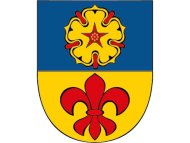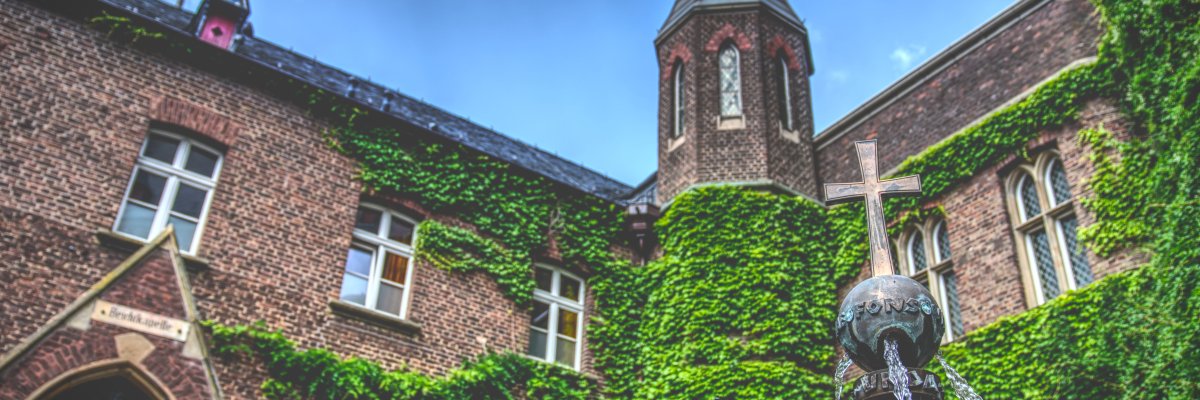Kevelaer
The district of Kevelaer has 17,501 inhabitants living on 1,946 ha (as of 31.12.2023). Kevelaer borders the municipality of Weeze to the north, the municipalities of Uedem and Sonsbeck (Wesel district) to the east, the town of Geldern to the south and the municipality of Bergen in Limburg, Netherlands, to the west. The farming community of Keylaer also belongs to the district of Kevelaer.
Coat of arms

"Divided, above in blue a golden (yellow) loquat blossom with red bosses and red sepals, below in gold (yellow) a red lily." By combining the medlar flower from Geldern with an element of the coat of arms of Kleve - a lily from the so-called "Lilienhaspel" (actually a carbuncle shield) - the coat of arms expresses the fact that the area of the municipality of Kevelaer, newly formed in 1969, sits astride an ancient territorial border, as it includes parts of the former duchies of
Geldern and Kleve.

The old coat of arms of the municipality of Kevelaer was replaced by the new one after the formation of today's town in 1969. It shows a golden cross on a blue background on the left-hand side and a three-leafed green clover on a golden background on the right-hand side.
History
First mention in the Middle Ages
The oldest surviving source in which the name Kevelaer appears, the deed of sale of a farm, dates back to 10 May 1300. Kevelaer was rural at that time and for a long time afterwards and consisted of scattered farms. Most of the region was owned by Xanten Abbey and Grafenthal Monastery in the 12th and 13th centuries. Kevelaer included the farming communities of Keylaer, Hegerath and Vorst and the southern farm of Hüdderath. These farming communities all belonged to the court of Wetten.
According to the tax list of the Geldern office from 1369, there were 31 houses, farms and cottages in the farming communities of Kevelaer. In the 14th century, Kevelaer was politically under Geldern counts and dukes. As a border town and not far from the fortress town of Geldern, Kevelaer was probably not spared the consequences of the inheritance disputes between the Geldrian dynasts Rainald and Eduard, sons of the late Duke Rainald II. For twelve years in the middle of the 14th century, these disputes were fought out with armed force in Gelderland and Klevisch.
St. Anthony's Chapel is elevated to parish church status
In the 15th century, Kevelaer was ruled by dukes from the House of Jülich, the House of Egmond and Burgundian dukes. In 1472, the town experienced an important elevation when St. Anthony's Chapel, located on the site of the current parish church, was elevated to the status of parish church. Kevelaer had another church in Keylaer, which was dedicated to St. Hubert and was probably in a better financial position until 1472. Around 1500, the desolate situation of the country was generally lamented. Kevelaer must also have suffered from the increasing violence in the country.
In the 16th century, Kevelaer was under the rule of the Dukes of Egmond, of Jülich-Kleve-Berg, under Emperor Charles V, under the States General (Dutch Republic) and under Spanish rule. In 1531, the St. Antonius Riflemen's Guild already existed in Kevelaer, which ensured security and order in the town for several centuries and was also responsible for welfare matters such as caring for the poor and the sick. In 1543, Emperor Charles V united the Duchy of Guelders, which had been defeated by his army, with the other 17 Dutch provinces. Twelve years later, Emperor Charles V resigned the government of the Netherlands in favor of his son Philip of Spain. Kevelaer belonged to the archdiocese of Cologne until 1559. At the request of King Philip of Spain, Pope Paul IV assigned Gelderland and therefore Kevelaer to the diocese of Roermond in 1559. The Spanish-Dutch Wars of Independence, which began in 1568 and lasted 80 years, and the Thirty Years' War (1618-1648) also brought much hardship and misery to the people of Kevelaer. When the conflicts took on terrible proportions, they sought shelter for years in bush-covered fortifications secured by a locked gate (entrenchments). Nevertheless, on August 1, 1635, more than 100 Kevelaers fell victim to brutal looting during an attack by Croatian mercenaries. As a result of the fighting, the Netherlands became independent from Spain in 1648, while Kevelaer and the Catholic Obergeldern remained under Spanish rule.
Hendrik Busman built a wayside shrine with a devotional picture
During the Thirty Years' War, shortly before Christmas 1641, a merchant from Geldern named Hendrik Busman heard a voice near a hail cross in the middle of the Kevelaerer Heide. He was told to build a chapel on this spot. When he heard the same words on two more days, his decision to comply with the request was made. The following year, a French army crossed the Rhine to join up with a corps from the Electorate of Hesse to fight the imperial army supporting the Spanish. In the same year, a month before Pentecost, Busman's wife Mechel saw a large, shining light at night, in the middle of which was a holy house with a devotional image that resembled a Luxembourg pilgrimage image that had recently been offered to her by imperial soldiers. She told her husband, who then bought the picture.
Hendrik Busman kept his promise and, despite adverse times, built a wayside shrine in the same shape as the one Mechel had seen, in the same place where he had heard the voice. On Sunday, June 1, 1642, the then Kevelaer parish priest placed the devotional image in the wayside shrine. The crowds were already huge that same year. The first closed procession came from Rees in 1643. This example was soon followed by processions from all over the surrounding area and the Rhineland. The first Kevelaer pilgrimage church, today's Candle Chapel, was built between 1643 and 1645. In agreement with the Archbishop of Mechelen, the Bishop of Roermond founded a branch of the Oratorians in Kevelaer in 1646. Kevelaer was approved as a place of pilgrimage five years after the installation of the holy image.
Kevelaer under Prussian rule
During the 17th century, there were repeated armed conflicts between France and Spain, with Kevelaer and the surrounding area suffering in particular during the long war of 1672-1679. In the War of the Spanish Succession, Prussia, allied with the Habsburg Emperor, then conquered large parts of Obergeldern; Kevelaer was thus under Prussian rule from 1703. The Prussian King Frederick William I visited the territory acquired in the Peace of Utrecht in 1713 and also Kevelaer in 1714. In 1738, he came to Kevelaer once again with his 26-year-old crown prince, the later King Frederick II. In 1742, the town then experienced a magnificent pilgrimage jubilee with pilgrims from all over Europe. During these developments, the former farming community slowly grew into a village with around 125 houses. During the Seven Years' War (1756-1763), the population once again suffered from the quartering of numerous soldiers.
Three years after the outbreak of the French Revolution and the storming of the Bastille, a troop of French soldiers from the revolutionary army invaded Kevelaer shortly before Christmas 1792 and extorted 15,000 pounds from the superior of the oratory. In October 1794, the Lower Rhine was occupied by Republican armies from the North, Sambre and Meuse. In 1800, a French-style administration was set up in the areas occupied by the French, with an upper prefecture in Aachen and regional sub-prefectures. Kevelaer belonged to the sub-prefecture of Kleve. Under Napoleon, who had ruled France as "Consul" since 1799, the dioceses were reorganized in 1801. Kevelaer was assigned to the diocese of Aachen (since 1821 Kevelaer has been part of the diocese of Münster). The Oratorian monastery in Kevelaer was declared state property by the French government in 1802, and the chapel of grace and candle chapel belonging to the monastery were sealed. The monastery and the churches (the churches were opened for services by order of the sub-prefect Dorsch) remained state property until 1806 (the churches) and 1807 (the Oratorian monastery).
With the defeat of Napoleon, the French authorities left the country in 1814 and from then on Kevelaer was once again under Prussian rule, as the entire Rhineland had been since the Congress of Vienna in 1815. As a result of the new state border, many places west of the Meuse, which had belonged to Gelderland before the French period, were separated. In 1816, the provisional administration of the Rhineland was dissolved and the new Prussian governments came into force. Kevelaer belonged to the district of Geldern, administrative district of Kleve (in 1822 the administrative district of Kleve was assigned to the administrative district of Düsseldorf). In the jubilee year of 1842 (200 years of pilgrimage), 254 processions came to Kevelaer.
The Crown Prince of Prussia, who later became King Friedrich Wilhelm IV, paid a visit to Kevelaer in 1833. During the Kulturkampf (1872-1878), the Protestant authorities issued numerous laws and ordinances and measures against the Catholic Church, which also caused controversy and uproar in Kevelaer. The Kulturkampf came to a head over the years. As a result, the Prussian government had the Oratorian monastery forcibly evacuated in 1876 and only released it again in 1880.
250 years of pilgrimage in Kevelaer
In the jubilee year of 1892, Kevelaer celebrated 250 years of pilgrimage. Pilgrimage numbers stagnated in 1914 due to the uncertain times. In the previous year, 344 special pilgrimage trains (Kevelaer had had a railroad station since 1863) and 600,000 pilgrims had been counted. In November of the same year, Kevelaer became a garrison town. After the end of the First World War, the first Belgian occupying troops arrived in Kevelaer in December 1918. Kevelaer was under Belgian occupation until 1926.
In Kevelaer, the Marian image was hidden under the tower of the basilica right at the beginning of the Second World War. The threat from the air increased in 1942, but the 300th anniversary, which fell during the war, was not hindered. On March 3, 1945, the Allied troops captured Kevelaer. A few days after the occupation, many evacuees from Kevelaer returned, hundreds of whom had already stayed in the place of pilgrimage. The reconstruction of the bombed districts of Kevelaer proceeded rapidly. In 1948, the first congress on international reconciliation was held in Kevelaer, hosted by the international Pax Christi organization.
Granting of city rights
On May 25, 1949, the municipality of Kevelaer was granted town rights by decree of the Minister of the Interior of the state of North Rhine-Westphalia. Twenty years later, on July 1, 1969, the municipal reorganization took place: "The town of Kevelaer, the municipalities of Kleinkevelaer, Twisteden and Wetten (Amt Kevelaer) and the municipalities of Kervendonk, Kervenheim and Winnekendonk (Amt Kervenheim) are merged to form an independent municipality. The new municipality is given the name Kevelaer and is known as the "town". The offices of Kevelaer and Kervenheim are dissolved."

